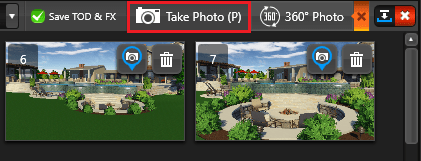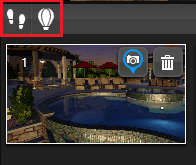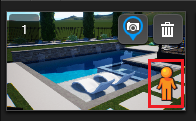Version 2: Photo Mode
Take high-resolution pictures and screenshots and save camera locations for the project with Photo Mode.
Think of this as a simplified 3D presentation. You can use all of the Presentation Mode controls except Video.

Getting to Photo Mode: To take photos of your project in Photo mode, go to the Finalize Phase.
Single left-click the Photo Mode button to load a 3D View with black border. To move around in 3D, use the standard mouse controls to rotate and pan and Walk (W) and Fly (F).

Saved Locations
Each project can have up to 99 saved locations. These locations function in both Photo Mode and Presentation Mode.
 New Camera Location: Press this button to add your current 3D view as a new Saved Location. You can also press (+) on your keyboard.
New Camera Location: Press this button to add your current 3D view as a new Saved Location. You can also press (+) on your keyboard.
By default your starting point in presentation is the first Location Slot. To start in a different location, double click on the Location Slot to set it. A small orange figure will appear on the starting Location.
TIP: To change the position of Locations, left click, then drag and drop them into the new position.

Location Slot Number: Left-click on the preview image to move your 3D view to that saved location. To move to a specific saved location while in Presentation Mode, Press the location number. For example, to move to Location 2, Press 2.
TIP: Copy and Paste locations between Photo Mode and Video Mode. Select the Location, press CTRL+C then CTRL+V to add the copy of the location.
Camera Pin: Press this button to update/change the Location Slot to the current view or different time of day. You can easily change or replace a Saved Location by moving your 3D view and pressing the camera pin icon again.
Trash: Press this button to Delete the saved camera location. You can also press Delete on your keyboard.
Take Photos
At any time, you can press the Take Photo button to capture a picture/screenshot of your current view. You can also press (P) on your keyboard.

To take photos of multiple Locations at once, press CTRL + Left Click or CTRL+A to select all locations.
Then press Take Photo to create a screenshot of each selected Location.
 When you successfully take a photo, the Photo Saved pop up box will appear and the screenshot will be saved in the screenshots folder.
When you successfully take a photo, the Photo Saved pop up box will appear and the screenshot will be saved in the screenshots folder.
Click on the Photo Saved box to open the Media Viewer and view the screenshots.
To learn how to send photos to a client, see How to Attach Project Images to Email.
Resolution: Take pictures/screenshots at the resolution you select from the drop-down. There are four Photo Resolution options: Email (Standard), Desktop (High-Definition), Print Size, and Poster Size.
Stage Options
 Footprints: Press this button to enter Walk mode or press (W) on your keyboard. Walk mode plants your feet firmly back on the ground so you can walk around. Press Esc to exit Walk mode.
Footprints: Press this button to enter Walk mode or press (W) on your keyboard. Walk mode plants your feet firmly back on the ground so you can walk around. Press Esc to exit Walk mode.
Balloon: Press this button to enter Fly mode or press (F) on your keyboard. Fly mode allows you to “fly” anywhere in the 3D view. Press Esc to exit Fly mode.
Save TOD & FX (Time of Day & Image Effects):

Check this box to save the time of day and image filter settings unique to each location.

Down Arrow: Press this button to minimize the Storyboard Tool Bar.
Red X: Press this X to close Photo Mode and return to the standard Presentation controls.
 Pegman: This marks the starting location in Presentation Mode. By default, the pegman is on Location Slot 1.
Pegman: This marks the starting location in Presentation Mode. By default, the pegman is on Location Slot 1.
To change the starting location, double click a Location Slot to remove the pegman to that slot.
360° Photos (Vip3D Exclusive)
360° Photos offers you the option of sharing with your clients the easiest, most engaging way to explore every detail of their future outdoor living space.
With 360° Photo, use the mouse on your PC, or the screen on your tablet or smartphone, to invite your clients to explore your design in any direction.
Take 360° Photos: Adjust your 3D view to select the perfect angle. Toggle the 360° Photo button On and click Take Photo (or press P).
Existing locations as well as new camera locations can be used to create both standard photos and 360° Photos.
NOTE: When 360° Photo is turned ON, all Photos taken will be 360° photos.
Once the 360° photo is taken, upload the image to Facebook to interact with it. Left click and drag the image using a PC mouse or use a mobile device such as smart phone to move the view.
While standard image viewing software will not display the image as a 360° or interactive photo, the image will upload correctly to Facebook.